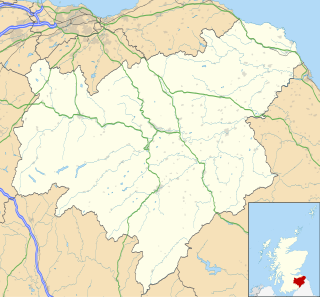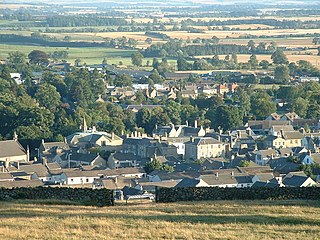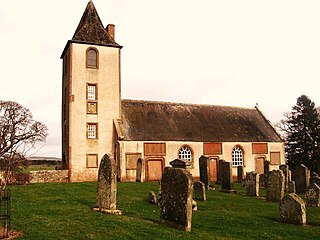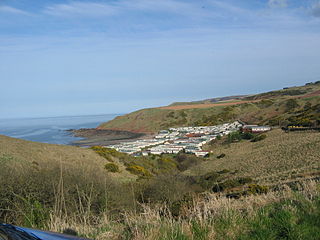
The Scottish Borders is one of 32 council areas of Scotland. It is bordered by West Lothian, Edinburgh, Midlothian, and East Lothian to the north, the North Sea to the east, Dumfries and Galloway to the south-west, South Lanarkshire to the west, and the English ceremonial counties of Cumbria and Northumberland to the south. The largest settlement is Galashiels, and the administrative centre is Newtown St Boswells.

Berwickshire is a historic county, registration county and lieutenancy area in south-eastern Scotland, on the English border. The county takes its name from Berwick-upon-Tweed, its original county town, which was part of Scotland at the time of the county's formation in the twelfth century, but became part of England in 1482 after several centuries of swapping back and forth between the two kingdoms. After the loss of Berwick, Duns and Greenlaw both served as county town at different periods.

Duns is a town in the Scottish Borders, Scotland. It was the county town of the historic county of Berwickshire.

Earlston is a civil parish and market town in the county of Berwickshire, within the Scottish Borders. It is on the River Leader in Lauderdale, Scotland.

Scotstown Moor is in the north of Aberdeen, Scotland.
Earlston RFC is a rugby union club, based at Earlston in the Scottish Borders.

Polwarth is a village and parish in the Scottish Borders area of Scotland. It is located at grid reference NT745502, between Greenlaw and Duns, in the former county of Berwickshire.

Gordon is a village in the Scottish Borders area of Scotland, within the historic county of Berwickshire. The village sits on the crossroads of the A6105 Earlston to Berwick on Tweed road and the A6089 Edinburgh to Kelso road. It is 6 miles (10 km) east of Earlston and 4 miles (6 km) west of Greenlaw.

Gavinton is a small settlement in the Scottish Borders area of Scotland, 2 kilometres (1.2 mi) south-west of Duns, the former county town of Berwickshire. The hamlet sits on a minor road off the A6105 Duns to Greenlaw road at grid reference NT767521.

Pease Dean is a nature reserve at Pease Bay, in the Scottish Borders area of Scotland, near the Anglo-Scottish border and Cockburnspath, Cove, and Dunglass. OS 67 NT794707.

Legerwood is a village by the Eden Water, in the Scottish Borders area of Scotland, near Lauder, near the Southern Upland Way.

Edrom is a parish and small village in the pre-1975 ancient county of Berwickshire, now an administrative area of the Scottish Borders region of Scotland.
Bemersyde Moss is a Scottish Wildlife Trust nature reserve and a Site of Special Scientific Interest at Bemersyde in the Scottish Borders area of Scotland. Located near the River Tweed, this reserve features a mix of marshlands, willow scrub, and open water, creating a vital habitat for diverse wildlife. It particularly hostsbirds in the warmer months and wintering wildfowl, such as teal, shoveler, goldeneye, and wigeon, during colder months. The site also supports mammals like otters, which can be observed throughout the year.

Cessford is a hamlet and former barony about a mile south of the B6401 road, in the Scottish Borders area of Scotland. The placename is from Gaelic 'ceis' and means 'the wattled causeway over the ford'; spellings vary between Cesfuird, Cesford, Cessfoord, Cessfuird, and Cessfurde.
Allanbank is a village near Allanton, in the Scottish Borders area of Scotland, in the historic county of Berwickshire.

The Crosshall Cross is a wheel-headed cross at Crosshall Farm, Eccles, in the Scottish Borders area of Scotland, in historic Berwickshire.

Dirrington Great Law is a hill in the Scottish Borders area of Scotland, in the former county of Berwickshire. The summit is around 2.5 kilometres (1.6 mi) south of Longformacus and 9 kilometres (5.6 mi) west of Duns. It is an isolated hill to the south of the Lammermuir Plateau. Dirrington Little Law is located 2 kilometres (1.2 mi) to the south-west.
Hare and Dunhog Mosses is a nature reserve near Selkirk, in the Scottish Borders area of Scotland, in the former Selkirkshire.

Hoselaw Loch and Din Moss is a nature reserve near Kelso in the Scottish Borders area of Scotland, in the former Roxburghshire. A lack of footpaths and the surrounding land being used by farms makes access tricky.















